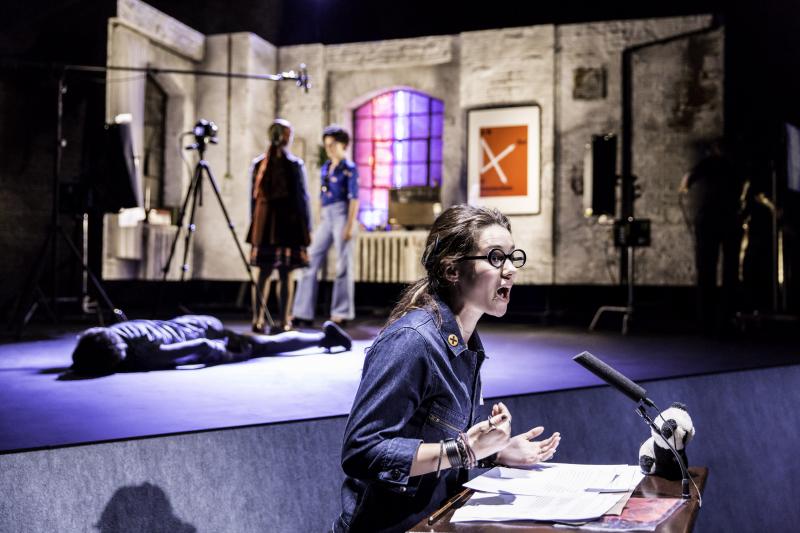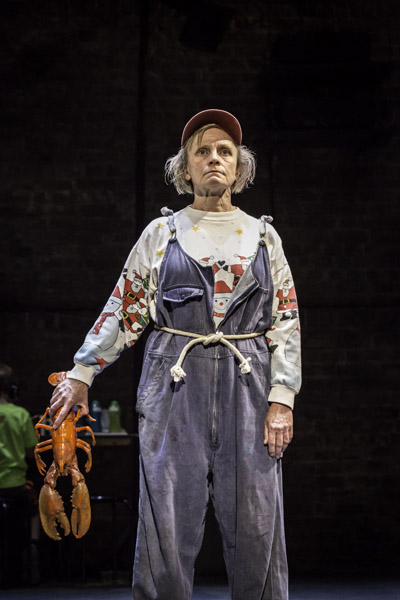Adler & Gibb, Royal Court Theatre | reviews, news & interviews
Adler & Gibb, Royal Court Theatre
Adler & Gibb, Royal Court Theatre
Tim Crouch’s new play is a thrilling experiment that stumbles at the final hurdle

Theatre-maker Tim Crouch has a thing about art. One of his plays, ENGLAND, was performed in art galleries across the world; another was called An Oak Tree, after the 1973 conceptual art piece by Michael Craig-Martin. In fact, Crouch even looks like an arty type. Now, in his latest production, he tells a story about two fictional artists: Janet Adler and her lover Margaret Gibb. But, really, his main theme, as ever, is the relationship between art and reality.
The audience arrives to see a bare set, on which two young kids are playing, with the bare-brick back wall of the theatre visible. There is a table at one end with the props, and a stage manager follows the action in the script. Then a Student approaches a lectern in front of the stage; she is giving an academic presentation about the now-dead Janet Adler, who was something of a radical anti-artist — destroying her own work; eating a critic’s painting; presenting a real puppy as an art object.
Crouch joyfully satirises academic descriptions of artistic creativity
When the Student pauses to show a slide to illustrate her presentation, what we see on stage is not the slide but Sam and Louise, a director and actor who plan to find the abandoned house where the two elusive women used to live — and make a film about them. From the off, it’s a strange project: Sam coaches Louise to play the part of Adler, and both are clearly surprised when they discover that Gibb is still alive.
This simple story gives Crouch the chance to joyfully satirise academic descriptions of artistic creativity, and to comment on how film-makers, art critics and biographers vampirise the lives of artists. But as well as laughing at the blood suckers who slurp the life out of creativity, Crouch also explores the nature of theatre, and theatrical representation. The two kids on stage play a variety of roles — from a deer to a dog to a corpse — but never in a literal or representational way.
In this play, there are many objects on stage, but they rarely stand for what they are in the story: a bit like conceptual art really. At various moments, Louise almost becomes Adler, wearing the dead woman’s clothes, imitating her accent. In fact, for the audience, what is the difference between watching an actress playing Louise playing Adler and watching an actress playing Adler? Likewise, the actor playing Sam has a Scottish accent, although he is meant to be an American.
 In the second half of a short evening the story takes a couple of disconcerting leaps, and things turn very ugly. After a delicious parody of the grave scene in Hamlet, the unpleasant ambitions of Louise take centre stage. And her thoughts are more shocking than the shallow grave that the creatives dig up. So far so good, but the imaginative staging is not quite fast-moving enough to prevent you noticing some holes in the plotting — unless everything we see is a dream, or a fantasy (which I always feel is a bit of a cop out).
In the second half of a short evening the story takes a couple of disconcerting leaps, and things turn very ugly. After a delicious parody of the grave scene in Hamlet, the unpleasant ambitions of Louise take centre stage. And her thoughts are more shocking than the shallow grave that the creatives dig up. So far so good, but the imaginative staging is not quite fast-moving enough to prevent you noticing some holes in the plotting — unless everything we see is a dream, or a fantasy (which I always feel is a bit of a cop out).
Actually, I loved this show until the final minutes, where I got the distinct feeling that Crouch’s ideas had run out of steam. The student’s presentation finishes weakly; the final filming doesn’t really make sense; and the arrival of the big screen is a distraction from the theatricality of the rest of the piece. Of course, I know that Crouch is comparing art forms, placing literal views of reality next to conceptual ones, but somehow the last part of the evening feels like the playwright is just doodling in the margins.
Before then there is plenty to enjoy in this production by Crouch, who along with Karl James and Andy Smith also directs, and the cast is committed and playful: please take a bow Denise Gough (Louise), Brian Ferguson (Sam), Amelda Brown (Gibb, pictured above) and Rachel Redford (Student). So while it’s great that the Royal Court is investigating the nature of theatre with such passionate verve, it’s sad that good old-fashioned storytelling has stumbled by the wayside.
rating
Explore topics
Share this article
The future of Arts Journalism
You can stop theartsdesk.com closing!
We urgently need financing to survive. Our fundraising drive has thus far raised £33,000 but we need to reach £100,000 or we will be forced to close. Please contribute here: https://gofund.me/c3f6033d
And if you can forward this information to anyone who might assist, we’d be grateful.

Subscribe to theartsdesk.com
Thank you for continuing to read our work on theartsdesk.com. For unlimited access to every article in its entirety, including our archive of more than 15,000 pieces, we're asking for £5 per month or £40 per year. We feel it's a very good deal, and hope you do too.
To take a subscription now simply click here.
And if you're looking for that extra gift for a friend or family member, why not treat them to a theartsdesk.com gift subscription?
more Theatre
 Stiletto, Charing Cross Theatre review - new musical excess
Quirky, operatic show won't please everyone, but will delight many
Stiletto, Charing Cross Theatre review - new musical excess
Quirky, operatic show won't please everyone, but will delight many
 Alfred Hitchcock Presents: The Musical, Theatre Royal Bath review - not a screaming success
1950s America feels a lot like 2020s America in this portmanteau show
Alfred Hitchcock Presents: The Musical, Theatre Royal Bath review - not a screaming success
1950s America feels a lot like 2020s America in this portmanteau show
 Wilko: Love and Death and Rock'n'Roll, Southwark Playhouse review - charismatic reincarnation of a rock legend
Johnson Willis captures the anarchic energy and wit of the late guitarist
Wilko: Love and Death and Rock'n'Roll, Southwark Playhouse review - charismatic reincarnation of a rock legend
Johnson Willis captures the anarchic energy and wit of the late guitarist
 Dear England, National Theatre review - extra time for stirring soccer classic
James Graham adds a neat coda to his ode to decency in sport
Dear England, National Theatre review - extra time for stirring soccer classic
James Graham adds a neat coda to his ode to decency in sport
 Weather Girl, Soho Theatre review - the apocalypse as surreal black comedy
A Californian weather girl copes with fires inside and outside her head
Weather Girl, Soho Theatre review - the apocalypse as surreal black comedy
A Californian weather girl copes with fires inside and outside her head
 Clueless: The Musical, Trafalgar Studios review - a perfectly manicured update
KT Tunstall's new score brings bite and momentum to a high octane evening
Clueless: The Musical, Trafalgar Studios review - a perfectly manicured update
KT Tunstall's new score brings bite and momentum to a high octane evening
 The Habits, Hampstead Theatre review - who knows what adventures await?
New play about the game of Dungeons & Dragons explores fact and fantasy
The Habits, Hampstead Theatre review - who knows what adventures await?
New play about the game of Dungeons & Dragons explores fact and fantasy
 Farewell Mister Haffmann, Park Theatre review - French hit of confusing genre, with a real historical villain
Jean-Philippe Daguerre tries to mix a farcical comedy of manners with the Holocaust
Farewell Mister Haffmann, Park Theatre review - French hit of confusing genre, with a real historical villain
Jean-Philippe Daguerre tries to mix a farcical comedy of manners with the Holocaust
 Edward II, RSC, Swan Theatre, Stratford review - monarchs, murder and mayhem from Marlowe
Putsch in the palace brings down a king who chose the wrong person to love
Edward II, RSC, Swan Theatre, Stratford review - monarchs, murder and mayhem from Marlowe
Putsch in the palace brings down a king who chose the wrong person to love
 One Day When We Were Young, Park Theatre review - mini-marvel with a poignant punch
Perfectly judged performances enhance a subtle staging of Nick Payne's two-hander
One Day When We Were Young, Park Theatre review - mini-marvel with a poignant punch
Perfectly judged performances enhance a subtle staging of Nick Payne's two-hander

Add comment